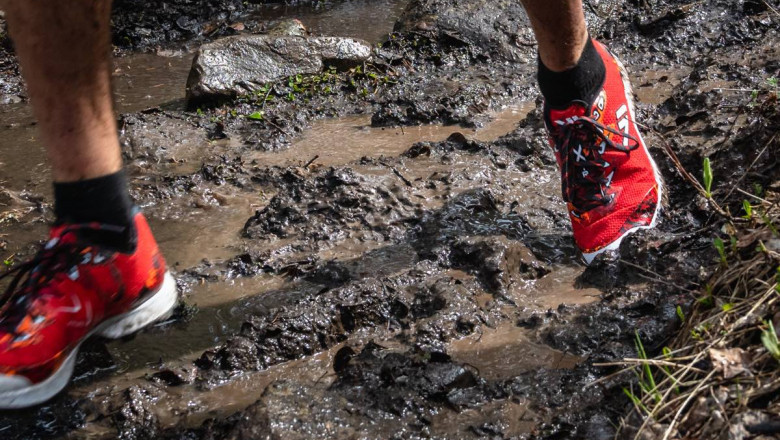views
Trail running has surged in popularity over the last decade, transforming from a niche activity into a mainstream sport. As more outdoor enthusiasts take to the trails, the demand for high-performance gear, especially trail running shoes market, has skyrocketed. The market for these shoes is constantly evolving, with brands continually innovating to meet the needs of the modern trail runner. From improved durability to enhanced comfort and sustainability, the latest innovations in trail running shoes reflect both technological advancements and a growing awareness of environmental impacts.
Technological Advancements: Enhancing Performance and Protection
Trail running requires shoes that can withstand a variety of challenging terrains, including rocky paths, muddy trails, and uneven surfaces. As such, manufacturers have invested heavily in research and development to create shoes that not only offer comfort but also improve traction, stability, and foot protection.
One of the most notable innovations in recent years is the development of advanced sole technology. Trail shoes now feature more sophisticated outsoles designed to provide superior grip and traction. Companies like Vibram have collaborated with running brands to design outsoles that offer multi-directional lugs, ensuring that runners can maintain control on slippery or uneven ground. These outsoles are crafted from specialized rubber compounds that provide increased durability, which is crucial for trail runners who often face abrasive surfaces.
In addition to enhanced traction, manufacturers have focused on cushioning and protection. Midsole technology has evolved significantly with brands like HOKA ONE ONE introducing highly cushioned models that don’t compromise on responsiveness. These shoes are designed to offer superior shock absorption, which is especially beneficial on rocky or downhill trails. Meanwhile, brands such as Salomon and Brooks have integrated more flexible midsoles that adapt to the runner's stride while still providing adequate protection from sharp rocks or roots.
Sustainability: A Step Toward Eco-Friendly Designs
As the outdoor industry becomes more environmentally conscious, sustainability has taken center stage in the trail running shoe market. Traditional running shoes are often made from materials that contribute to pollution, including plastics, rubbers, and synthetic fabrics that are non-biodegradable. To combat this, several companies have turned to more sustainable materials in their shoe construction.
Recycled materials are one of the most significant trends in trail running shoe innovation. Many brands now use recycled plastics, such as PET, for shoe uppers and outsoles. For example, Adidas has launched the Ultraboost DNA Loop, a fully recyclable shoe, and brands like Altra are using post-consumer recycled materials to construct shoe components. These shoes are designed to be disassembled at the end of their life cycle, which ensures minimal waste. Other materials such as organic cotton and recycled nylon are also being used to replace traditional synthetic textiles, providing an eco-friendly alternative without sacrificing performance.
Additionally, some brands are introducing biodegradable insoles and water-based adhesives that further reduce the environmental footprint of their footwear. This shift toward sustainability has not only resonated with eco-conscious consumers but also pushed the industry as a whole toward more responsible manufacturing practices.
Customization and Fit: Personalized Trail Running Shoes
Another key innovation in the trail running shoes market is the growing focus on fit and customization. Proper fit is crucial for preventing blisters, improving comfort, and enhancing performance, especially on rugged trails where every step counts.
To address this, several brands now offer customization options that allow runners to fine-tune their shoe's fit. Brooks Running, for example, offers a range of models in different widths, while brands like Nike have developed shoes with adjustable features, such as dynamic lacing systems that allow runners to change the fit based on their needs. Custom insoles and footbeds are also becoming more common, offering personalized arch support and cushioning to suit individual foot shapes.
Advanced foot scanning technology is another emerging trend. Retailers are increasingly offering 3D foot scanning to measure foot length, arch type, and pressure points. This data is then used to recommend the best shoe for each runner, ensuring a highly personalized fit. Brands like Saucony and ASICS have integrated this technology into their design processes, offering shoes that cater to runners with specific gait mechanics or foot characteristics.
Lightweight and Breathable Designs
Trail runners often face extreme conditions, whether it’s heat during summer runs or cold, wet conditions in winter. As a result, lightweight and breathable shoe designs have become a priority for manufacturers looking to enhance the trail runner’s experience. Brands have made significant strides in creating shoes that are both durable and lightweight, reducing the overall weight without compromising on the shoe’s ability to protect against rough terrains.
Modern trail running shoes incorporate breathable meshes and lightweight fabrics that offer increased airflow, keeping the foot cooler and drier during long runs. Shoes are also being designed to be more water-resistant, providing protection against rain and stream crossings without being too heavy or uncomfortable.
Conclusion: The Future of Trail Running Shoes
The trail running shoes market is experiencing rapid innovation, with technological advancements, sustainability initiatives, and a focus on customized fit driving the evolution of the industry. As trail runners continue to seek improved performance, durability, and comfort, shoe manufacturers are pushing the boundaries of design and material science. The future of trail running shoes looks bright, with continued innovation promising a better, more sustainable running experience for outdoor enthusiasts everywhere. Whether it’s an eco-friendly design or a new cushioning technology, these innovations are ensuring that the gear keeps up with the increasing demands of trail running.






















Comments
0 comment